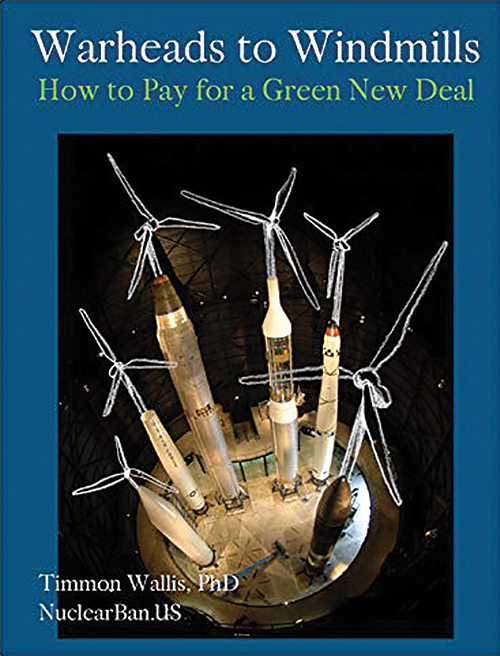
Warheads to Windmills: How to Pay for a Green New Deal
Reviewed by Brian Drayton
September 1, 2020
By Timmon Wallis. NuclearBan.US, 2019. 70 pages. Available to order (hardcopy for donation) or download (free PDF or eBook) at www.nuclearban.us/w2w.
It is easy to be overwhelmed by the number of processes now threatening the stability of human civilization. Issues like racial or social injustice, the world’s addiction to war, or various kinds of state oppression are joined by climate change, nuclear proliferation, soil degradation, and (the one that most worries me) biodiversity loss. As we try not to be overwhelmed by the needs pulling at us, we turn with relief to advice like Thomas Kelly’s: to “live from the Center,” simplifying by dedication to a few concerns.
It helps to see where concerns naturally relate. This is the view offered by the report “Warheads to Windmills,” produced by NuclearBan.US, a U.S.-based nonprofit “committed to the total elimination of nuclear weapons.” Wallis argues that as we turn the roadmap offered by the Green New Deal (GND) into specific policies, we can (and must) address climate change and related environmental concerns, economic inequality, and the dangers of nuclear weapons, and he argues that economic injustice makes the other two crises more likely, and more damaging.
Part 1, “Facing Up to Three Life-Threatening Emergencies,” offers basic information about each of the issues and discusses how they intersect, as well as a short introduction to the Green New Deal. This intersection is epitomized by the challenge that “Avoiding the most extreme effects of climate change will require . . . a 45 percent cut in global carbon emissions by 2030,” and carbon neutrality by 2050. These changes will require a society-wide research and development effort, involving a wide array of new job opportunities at every level of skill, and will cost an estimated $200 to $300 billion investment per year in the United States alone.
Funds on this scale will only be available if we significantly shift governmental spending priorities, and Wallis argues that our vast annual investment in nuclear weapons is one area that can help. An important added benefit is the reduction of the environmental damage attendant upon nuclear weapons production, storage, and use. A final element in the picture that Wallis paints is the need for international cooperation on all these efforts.
Part 2, “Solutions—A Green New Deal,” argues that we must recognize that the U.S. reliance on “market forces” is not adequate to the kinds of radical and swift yet strategic actions on a broad scale that are now needed, since we have largely underplayed our response to climate change in the 30 years since the scientific picture became clear. The focus has to be on reducing emissions both by energy efficiencies and by a broad conversion of our energy system to electric modes of transport and heating, while generating the electricity from renewable sources. It will also entail a careful but dramatic redesign of the ways people now produce food and manage land, water, and forests.
The challenge for policymakers and implementers is that we must directly and effectively educate the public and stimulate public participation, or no real change will be possible. Crafting solutions that mitigate the current economic inequities is a central requirement if we are to meet our emissions goals. Wallis writes:
If the net result of government measures to address the climate crisis is that large numbers of people end up in the same economic condition as they are now, or even worse off, they are unlikely to accept it. And without cooperation from citizens, it is hard to see how these measures can succeed.
Part 3, “Solutions—The Nuclear Ban Treaty,” argues that the UN’s 2017 Nuclear Ban Treaty offers a feasible path toward elimination of the nuclear weapons enterprise—development, production, stockpiling, and possible use—with its attendant environmental, economic, and human costs. Wallis argues that a key element of a successful climate strategy should include getting the United States to sign and abide by the Nuclear Ban: We neither participated in its development, nor ratified it, and if the world’s premier nuclear power does not participate, the treaty is rendered impractical.
Part 4, “It’s Not Just About the Money,” discusses the potential economic benefits to workers that would result from the implementation of a Green New Deal. Though (based on figures from the U.S. Bureau of Labor Statistics) I question his estimates of new STEM (Science, Technology, Engineering, and Mathematics) jobs, the numbers overall are compelling.
As Naomi Klein wrote about the climate crisis, “This changes everything.” Wallis’s report is a valuable brief guide to such changes, integrating the key points of hundreds of research and policy documents. It can be useful for advocates, educators, and activists, both as a source of arguments and evidence, and as a guide to collaborative action across many concerns.
Brian Drayton worships with the Souhegan Preparative Meeting in southern New Hampshire.


